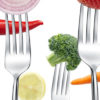
Me Want Cookie!!!
I remember as a kid going over to my friend’s houses and being amazed that there were candy and cookies just sitting in the cupboards.
In my house, that would never happen. If we had candy or cookies around, us girls (me, my sister and my mother) couldn’t rest knowing that there are sweets nearby. We would just keep going back to the cookies until they were all gone. In fact, we didn’t even have a cookie jar because there was no point. If we made cookies, those treats barely had a chance to cool before they were gobbled up.
My father would witness these feeding frenzies, shake his head and say something about ‘moderaton is the key” while we rolled our eyes. Moderation? With cookies?!?
Like most people, we believed that our inability to stop eating sweets once we started was willpower based. While this may be true at times, much of the drive toward snacking and sweets is actually coded in our DNA.
Sweets, Sweet Perception and the Feedback Mechanism
The perception of sweet taste and for the way our brains respond when we taste something sweet is part of our genetic makeup.
One of the most impactful genes that code for our behavior around sweets is labeled as TAS2R38. TAS2R38 is known as a taste receptor gene, sometimes called the ‘sugar gene’ or the ‘cookie jar gene’.
When you have normal variants of this gene you are considered a taster and you will taste more bitterness with coffee, with cruciferous vegetables, and with more bitter tasting fruits like grapefruit. This doesn’t necessarily mean that you dislike those foods. It just means you have a bit more perception of the bitter taste.
If you have the recessive allele you are considered a non-taster. Having the recessive allele can have pretty profound implications. This means when you go to the cookie jar, and have one cookie, you tend to go back and have more and more until that cookie jar is empty.
This is TAS2R38 gene at work. It causes something called “disinhibition of appetite”. Disinhibition of appetite means that when you are presented with a stimulus (the sweet taste), it turns off the feedback mechanisms that tell you that you’re full or satiated, so you can want to eat and eat.
This is something that we see a lot in people that are going through weight-loss programs. They say they have this tendency that when they get started eating something sweet, they just can’t stop.
These folks struggle with this and say, “Well, I have no willpower when it comes to sugar and sweets.”
It’s not a matter of willpower if you’re carrying this gene – this is a gene that actually codes for turning off your inhibitions of eating. It’s not a lack of willpower or anything like that.
Here’s how it works, and what you can do about it.
You don’t have to enroll in a study to find out if you have the cookie jar gene. DNA analysis through 23andme can easily tell you your taste receptor genetics. (I have no relationship with the company by the way)
Here’s how you figure it out, once you get your 23andme report:
- At the home screen, look up at the right-hand corner and click on your name. You’ll see a drop-down menu under your name. Scroll down and select “browse raw data.”
- You’ll be brought to a new page. In the middle of the page, you’ll see a text box that says, “Search for a specific gene or marker (SNP).” In this text box, enter rs1726866, and press “Go.”
- You should see another page now that displays chromosome 7 (where this polymorphism is situated). Below it, you will see TAS2R38, and your genotype.
If you have GG, you’re probably a ‘taster’ and have an easier time consuming moderate amounts sweets. If you have AA, you have the at-risk genotype. This isn’t 100%, but it does give you a high probability that as a non-taster you are consequently more likely to be that person who has a tendency that when you taste something sweet, you’re going to want to go back to it again and again.
Practical Implications
I counsel people with the cookie jar gene that it’s ok to have that sweet but they need to make sure that they are in a situation where they don’t have an unlimited supply.
This means that if you’re going to have that cookie, make sure there’s only one cookie that you have access to. Because if that gene gets turned on you’re going to be really finishing that cookie jar. This means instead of buying a whole box of cookies, pick up just one at the bakery counter or checkout line.
If you are heading to a party or know you are going to be in a situation where you’ll be surrounded by unlimited sweets, there an herb that can help. The herb is called Gymnema Silvestre. It’s been used for centuries in traditional medicine as a treatment for diabetes. In fact, the Hindi name for this herb translates to “destroyer of sugar.”
Studies have shown the Gymnema molecules closely resemble the sugar molecule and may compete for binding sites on the receptors of the tongue that sense “sweet” flavors, blunting the sweet taste. So when you eat something sweet, it doesn’t actually taste sweet and keeps the cookie jar gene from being turned on.
Epigenetics: the study of how mechanisms – such as diet, lifestyle choices and behaviors, and stress – switch genes on or off, changing the health not only of the people who are exposed to them but also the health of their descendants.
Take Away
Your genes interact with your environment. Knowing how to manage your environment to achieve your desired outcome is the focus of a line of study called, “epigenetics”. Epigenetic literally means ‘on top of genetics”, therefore, epigenetics is an overlying template to your genetic code.
You can’t change your genetics, but you can change how your genetics impact your life!







